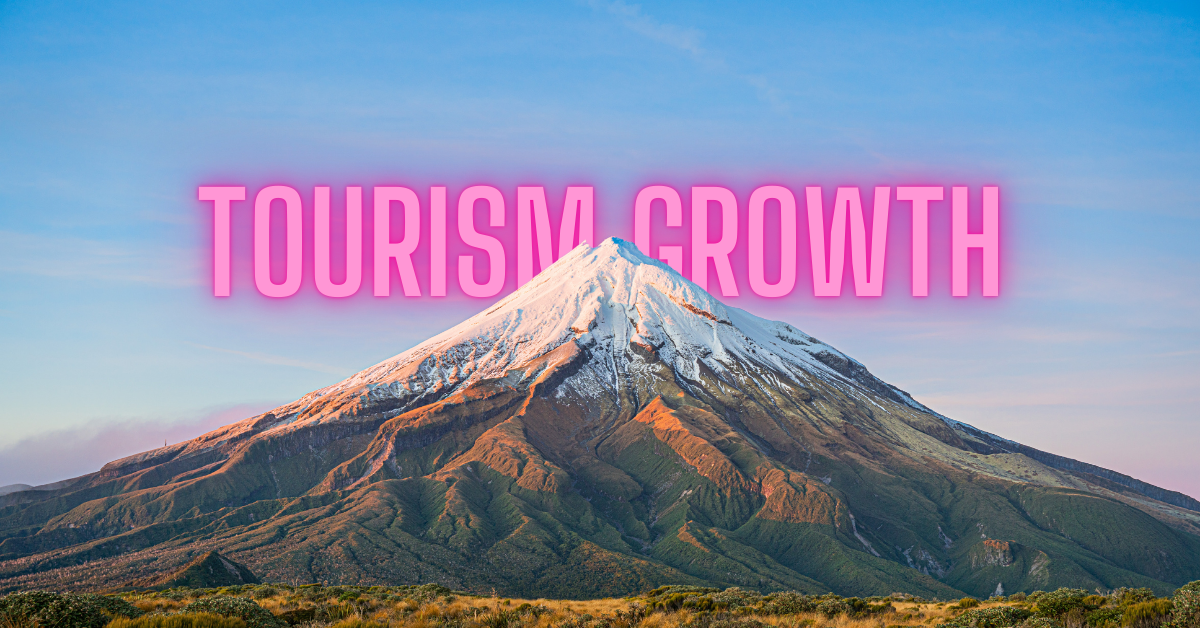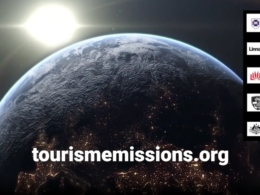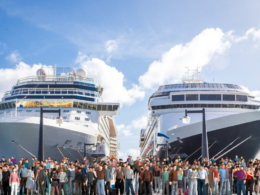My return to work this year coincided with several tourism announcements from the New Zealand government. Its announcements amount to a slash and burn approach to economic growth, and blind focus on tourism growth without concerns for those who live with tourism. The current government’s plans for the visitor economy are void of any thinking or any evidence of commitment to sustainable tourism.
Transcript:
Upon return to work after the summer holidays, the Minister for Economic Growth Nicola Willis announced that driving high growth in international tourism will be a major focus of her economic growth strategy. Willis was backed up in the press conference by Prime Minister Luxon who said that “tourism has a massive role to play in our growth story”. The message is clear: We want all tourists! An undifferentiated approach that is driven by volume.
Willis plans to ease tourist visa requirements, boost overseas marketing, consider the best use of funding from the international visitor levy (more on that to follow), and work with airlines to pursue maximum tourism growth. After that, according to Nicola Willis, it is up to tourism providers to quote “…do everything that they can to get as many dollars out of those back pockets as possible.”
She said that “Our message is actually when we’ve got more tourists coming, more tourists spending, that’s good for jobs, it’s good for growth and it’s good for the wealth of individual New Zealand families so that’s what we’re driving for.”
Unfortunately this blind focus on volume ignores lessons learned the hard way, around the world and in New Zealand, that high growth tourism comes with a wide range of negative impacts.
Unsurprisingly, mayors, tourism industry organisations and regional tourism organisations have been quick to respond, drawing attention to the fact that a focus on tourism numbers must be accompanied by a conversation about visitor management and, most critically, government funding of tourism infrastructure. This, we know, is particularly acute in areas with low numbers of ratepayers relative to visitor numbers, where the burden of visitor arrivals has, for far too long, fallen upon those who live with the reality of overburdened local infrastructure and services.
The impacts of tourism on local environments, community infrastructure and local residents is well documented. Most recently, last year a Tourism New Zealand study reported that 68% of residents had been negatively impacted by tourism. This was up from 65% the previous year.
In 2019 the inaugural Tourism Policy School that we hosted in Queenstown debated the theme Tourism growth: Volume versus value. The consensus was clear at that time, that we must pursue high value tourism, where value can be expressed not only in economic terms but in social, cultural and environment terms in combination, as opposed to the exclusive historical focus on volume growth.
‘Regenerative tourism’ emerged as a concept that captures the need for a focus on value over volume, where conscious policy and regulatory settings foster sustainable and equitable growth that is inclusive of community engagement in tourism planning. Under the previous government MBIE tourism officials went to great lengths to define and embed regenerative tourism principles in tourism policy and planning.
This required careful consideration of tourism growth pathways, conscious decision making and inclusion of local communities, as underpinning the Destination Management Plans successfully created by all 31 regional tourism organisations in NZ during the COVID pause. The approach now being advanced by the current government ignores all of these recent tourism planning efforts.
****
The rates at which tourism can grow today is out of all proportion with the past and tourism growth does need to be very carefully managed.
When I was studying tourism as a student in the 1990s growth in tourism demand was typically measured in the range of 1-2% increases in visitor arrivals per annum. Annual growth of 3-4% if sustained over a few years was more than enough to strain destination communities.
In 2024, Europe’s tourism numbers surpassed 2019 figures, with an annual increase of 12% since 2023. Portugal, which had its share of overtourism challenges, saw a 26% increase in arrivals in 2024.
Fortunately is it not governments alone that shape the future of tourism. Destination managers and city authorities have tended to fill the void where government policy and planning for tourism has fallen short of what is required.
Many European cities, most notably Venice and Amsterdam, have increased tourism taxes and banned cruise ships in their historic precincts. New York and Barcelona are implementing or announcing regulations on Airbnb and other rental platforms which have heavily impacted residential communities in popular destinations. Anti-tourism demonstrations are now common in the European summer where growth in tourism contributes to inflated housing costs, resident displacement and crowded public transportation.
****
Growth in tourism is a fascinating and hotly debated topic with very contrasting views on its merits. Often talk about tourism growth is framed by reference to pre-pandemic levels, as if that is the benchmark that needs to be achieved as an immediate priority just to get back to where we once were.
In fact last month in January 2025 UN Tourism announced that 1.4 billion international tourist arrivals were recorded globally in 2024, marking the full recovery of international tourism following COVID-19. Of course the recovery has varied between countries and regional. The majority of destinations now receive more international tourists than they did before the pandemic.
In New Zealand we are not quite back to pre-pandemic levels although there are regional variations – The Queenstown Lakes district has more tourists visiting now than it did before the pandemic.
The problem is that before the pandemic there were major problems with overtourism, as documented by the Parliamentary Commissioner for the Environment in reports published in 2019 and 2021. And tourist carbon emissions remain a major problem for New Zealand tourism.
There has actually been little debate about the desirability of returning to pre-pandemic levels.
When the government announced its blunt tourism growth strategy Queenstown Mayor Glyn Lewers said that “When I first started as the mayor, I think it was one resident night to every 30 visitor nights. It is now one to 47″. He noted that a significant burden falls upon residents and the ratepayers in Queenstown, and that tourism’s social licence has long been in decline.
He has argued that tourism growth must be accompanied by quote “…a very serious investment in actually accommodating those visitors because a small ratepayer base can not sustainably keep supporting the tourism industry”. Support is required to pay for roads and pipes and other infrastructure investments needed to cope with additional visitors.
It was pleasing to hear words of wisdom from Tourism Industry Aotearoa chief executive Rebecca Ingram on this subject. She noted some scope for carefully planned growth, while highlighting the important point that we must “ensure that we’re investing in New Zealand to make sure that the growth that we do receive occurs in a balanced way”. That economic, community and environmental considerations must be taken into account when thinking about how we want to grow.” The focus must be on balanced and sustainable growth.
Many New Zealand destinations having got back to pre-pandemic levels are also back to the problems that accompanied over tourism prior to the pandemic. That means that more and more residents in overrun destinations resent the impacts of sustained high tourism growth on their communities.
Very serious investment in tourism infrastructure is required, with support for regional destinations to manage tourism through resourcing and financing, without burdening ratepayers. These are not new ideas. The problems of tourism growth are well documented. But this government seems to be happy to ignore the problems that have emerged in the past with sustained high tourism growth, which will inevitably be repeated in the future.
****
In late January the government also announced new visa rules which aim to draw ‘digital nomads’ – people who work for a foreign employer while travelling. This is a strategy that has been used in other countries to target a market that are highly skilled, well paid and able to stay much longer than most leisure visitors because of their capacity to combine work and leisure. Of course those who spend longer at a destination have far greater opportunity to contribute to local spending. It is expected that the duration of the visa will range from six to nine months.
Tourism Industry Aotearoa welcomed the change, but noted growth needed to be sustainable and well-managed. Digital nomads I would argue are worthy of encouragement far more so than visitors with short length of stay, low spending and high carbon emissions – for which we need look no further than cruise passengers.
And yesterday the government launched a new tourism campaign targeting Australian tourists which was announced by the Prime Minister and new Minister for Tourism, Louise Upston. The focus is to see more Australian’s travelling to New Zealand to fill up our airlines and hotels, according to the Prime Minister. The focus is – once again – all about accelerating and growing tourism.
That said, if any tourism markets are to grow, it is preferable that it is the Australian market. Not in the interests of short term growth, as in the announcement by the government, but because Australia is by far our most important and lowest emissions visitor market, by virtue of the fact that it is our nearest visitor market. It’s international air travel emissions are about 15% that of visitors coming all the way from Europe. That has to be a good thing.
****
In announcing her desire for tourism growth Willis made some mention of funding. She did not rule out boosting Tourism New Zealand’s funding, but said the first step would be examining how it was using its existing funding and if it was the best use of the funds.
It did seem a bit odd to me that this is not an initiative that involves Tourism New Zealand, which has a government budget specifically for international tourism marketing.
It has now emerged that the government will use $500,000 from the international visitor levy (IVL) for its own Australian marketing campaign. The background to the IVL was very usefully explained recently by James Shaw when she spoke late in the day at the Tourism Industry Summit in November last year.
James Shaw negotiated the introduction of the IVL in the Green Party’s first term in coalition government in 2017. It was intended to be ringfenced for investment in conservation and ecosystem restoration. The logic behind the IVL was that 80% of all visitors to NZ visit natural areas and two-thirds visit the conservation estate. Therefore nature is New Zealand’s single most important tourism infrastructure.
James Shaw explained that his vision at the time was that a portion of GST would be shared with local government perhaps supplemented by local bed taxes, to pay for hard infrastructure such as public toilets and waste facilities.
Compromises were made to introduce the IVL and it ended up being a watered down version of the original set of intentions, such that implementation of the IVL has directed significant funding to much needed infrastructure, based on requests for funding from local councils and a transparent process, rather than nature conservation which was the original intention.
Now we find that the current government is using half a million dollars of IVL funding for either nature conservation or tourism infrastructure, but rather for a marketing campaign. This is a cynical misuse of IVL funds for a purpose for which those funds were never intended.
****
All in all – these are major failings of the current government. A blind adherence to growth, with absolutely no concern or consideration given to decades of research, here and around the world, that makes it abundantly clear that you can not keep pouring more and more tourists into a finite tourism system. Frustrated by this governments slash and burn approach to economic growth, and blind focus on tourism growth without concerns for those who live with tourism, would be an understatement. And use of the IVL for tourism marketing is a cynical misuse of funding. This government really does need to be held to account for this mis-management of tourism.








